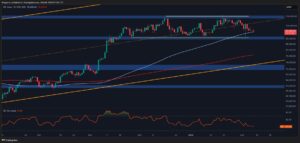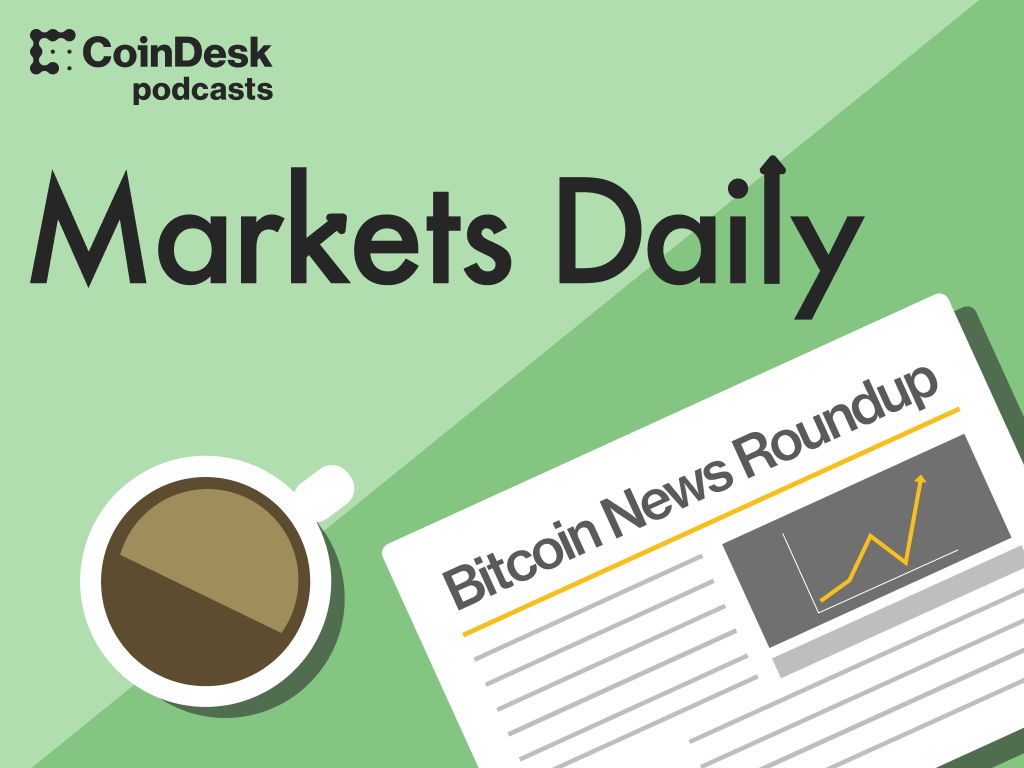To get the show every day, follow the podcast here.
On “Markets Daily,” host Jennifer Sanasie speaks with Dessislava Aubert, senior research analyst at Kaiko, about how markets reacted to yesterday’s FOMC meeting rates decision.
Consensus is where experts convene to talk about the ideas shaping our digital future. Join developers, investors, founders, brands, policymakers and more in Austin, Texas from May 29-31. The tenth annual Consensus is curated by CoinDesk to feature the industry’s most sought-after speakers, unparalleled networking opportunities and unforgettable experiences. Take 15% off registration with the code MD15. Register now at consensus.coindesk.com.
This episode was hosted by Jennifer Sanasie. “Markets Daily” is executive produced by Jared Schwartz and produced and edited by Eleanor Pahl, alongside Senior Booking Producer Melissa Montañez. All original music by Doc Blust and Colin Mealey.
Audio Transcript: This transcript has not been edited and may contain errors.
JENNIFER SANASIE:
Let’s get right into it and talk about that FOMC meeting yesterday, a lot of analysts expecting to hear that rate cuts are on the horizon. And we didn’t hear that yesterday. What do you make of that?
DESSISLAVA AUBERT:
Oh, yeah, maybe before going into the FOMC meeting, I will start with some some background context about the macro environment. We have had a lot of loosening of macro conditions in late 2023. And the reason for this is that inflation has been going down significantly. And the markets have been pricing in quite a bit of rate cuts for this year. So the Fed has been pushing against market expectations for some time now. We had Fed speakers kind of trying to moderate market expectations. And essentially what happened yesterday is that the message we got across from the Fed was inflation is indeed going down, but they will need to see more data before rate cuts. And essentially, market expectations for the March rate cuts went down significantly from more than 50% just before the press conference to 36% after. So this is why we had this negative reaction from bitcoin. Bitcoin went down almost 2% in the hours after the meeting can of course, equities was also a trading softer.
JENNIFER SANASIE:
Do you think we’ll see rate cuts later on this year?
DESSISLAVA AUBERT:
Oh, yes, definitely. I mean, overall, the macro backdrop to me is supportive for risk assets. It is clear the U.S. rates have peaked and we are going to see rate cuts. They’re projecting officially three rate cuts from this year. I think the main issue was that the markets were a bit overly optimistic after slower than expected inflation data for some months, we had this inflation slowing down significantly for six months in a row. So we were bracing a bit too many rate cuts. But overall the Fed is going to start cutting rates and this will be positive for bitcoin for risk assets in general.
JENNIFER SANASIE:
You mentioned that bitcoin was down on the news yesterday. And like you said tech stocks, equities were also down on the news. How do you expect markets to continue to perform ahead of a possible rate cut in the late spring, early summer?
DESSISLAVA AUBERT:
We have been seen some volatility. And as the market is shifting away from this ETF narrative and looking into the next narrative, I expect volatility to continue until we have more certainty around the rate cuts. For now. I think the U.S. economy remains strong. The Fed was clear, essentially they can afford to wait. We had some very, very strong U.S. data for last week, we had GDP coming above expectations we have this week, jobs markets data, job openings were above expectations as well. So overall, as long as the U.S. economy remains strong, they can afford to wait a bit. I guess the short term price moves we’ve seen now is mainly related to markets pricing out some of the rate cuts that were pricing back in December. But we are going to see easing in monetary policy and this will support risk assets in the long term and as the dust settles around the ETFs we have seen a lot of rotation between products with outflows from GBTC but they have been slowing down. So demand is going to start coming into the market and this will also support the market.
JENNIFER SANASIE:
Something being mentioned in many of the headlines this morning are the references of a sound and resilient banking system in the U.S. being removed from all remarks at the Fed meeting. What do you make of this? What should we take away from this?
DESSISLAVA AUBERT:
Yes, maybe one important thing to mention is that we were expecting some details around the balance sheet run off. In the last Fed FOMC meetings, we had some mentions about the possible slowing in quantitative tightening. The Fed has essentially rates regulation and also balance sheet runoff in order to kind of manage liquidity in the system. And I think one of the main uncertainty remains of how much and how further they can go in reducing their balance sheet. We have seen that the U.S. banking system has shown some weaknesses just yesterday, we had actually one of the regional banks, the New York Community Bank, so its shares plummeted by more than 40%. It is the bank that actually acquired Signature, one of the crypto friendly banks, which went bankrupt. Some of the weakness was related to the commercial estate sector. So there are some weaknesses there. And it comes at a time when the Fed actually announced they’re going to stop supporting banks via their emergency liquidity program. So there are some some questions around how much and how long they can continue tightening their balance sheet, and we did not get a lot of details yesterday. Essentially, what we heard from Jay Powell is that they’re going to discuss this in March. So I think it’s an important questions as to how far that they can tighten in withdrawal liquidity without something breaking.
JENNIFER SANASIE:
On this show and on CoinDesk we talk a lot about what’s going on in the crypto markets. Are you seeing any correlations right now between crypto markets and TradFi? Or are they diverging from each other?
DESSISLAVA AUBERT:
If we talk about correlation, bitcoin has been mostly correlated with the NASDAQ over the past year, we know that the average correlation between bitcoin and the NASDAQ was around 60%. In 2022, it collapsed completely in 2023. And we it has been close to zero on average, bitcoin has been mostly driven by the ETF hype. But nevertheless, the macro context has been playing an important role in in the recent rally, we know that the macro background improved significantly 920 23. And this has been supporting crypto especially altcoins. So I think it is still very important right now when when the ETFs were already approved, we are still waiting to see how much new demand is coming into the market. And the macro backdrop is going to support this additional demand. In the long term, we do think that these instruments are going to open the way for a new array of investors. But for now, the map has been a bit slower to kick off in the macro backdrop will definitely support new investors coming into the market, especially for altcoins.
JENNIFER SANASIE:
You mentioned altcoins there twice. Altcoins are seeing a little bit of a revival since the market downturn last year. Are you watching any alts in particular?
DESSISLAVA AUBERT:
Well, we we have been watching altcoins, particularly because it’s very, very important for the market to see. I mean bitcoin has been dominating markets over the past year and it has been driven by its own narrative. We have been waiting for altcoins and Ethereum to start picking up in order to see a broad market recovery. It has been a bit slow but in the fourth quarter finally we saw altcoins volume starting to pick up and this was directly related to the macro backdrop. Now, after the approval of spot ETFs, there has been some volatility but overall volumes as they were above $10 billions for altcoins, which is quite significant. I do think with the macroeconomic policy, we will see some more inflows coming into the market for altcoins.
JENNIFER SANASIE:
Now quickly before we wrap, you mentioned the spot ETF and attention has turned to that spot ether ETF, some analysts thinking we could get an approval there in May. Do you think 2024 is going to be the year for ether? And if so, do you think we could see the price reach? I think that Standard Chartered was saying the price could reach $4,000 by May.
DESSISLAVA AUBERT:
Well, Ethereum has been underperforming bitcoin for the past year since the merger. Actually, we have seen some rotation into Ethereum after the approval spot bitcoin ETFs because the markets are expecting that they will be in the process similar instrument for Ethereum, and the first final deadline is May, however, it was mostly spot driven the derivative markets yet to start speculating on an Ethereum spot ETF.
JENNIFER SANASIE:
Thanks so much for joining “Markets Daily.” That was a senior research analyst at Kaiko Dessislava Aubert. That’s it for today’s show.
Read the full article here








